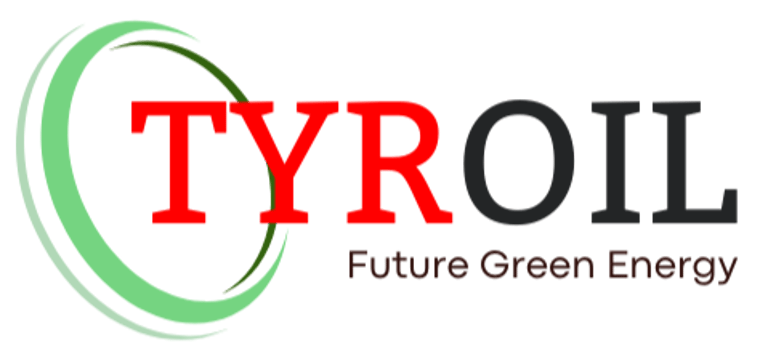The Untapped Goldmine: A SWOT Analysis of Tire Pyrolysis Oil in the Global Market
THE STORIES
TYROIL
6/30/20256 min read


Imagine a world where mountains of waste are transformed into valuable resources, fueling industries and powering a sustainable future. This isn't a distant dream; it's the tangible promise of Tire Pyrolysis Oil (TPO). For decades, discarded tires have presented a monumental environmental challenge, piling up in landfills, posing fire hazards, and leaching harmful chemicals into our ecosystems. But beneath this seemingly intractable problem lies an untapped goldmine, a circular solution that converts these rubber mountains into a versatile liquid fuel and other valuable by-products. As the global push for sustainability intensifies, understanding the business feasibility of TPO becomes paramount. This article delves into a comprehensive SWOT analysis, revealing the Strengths, Weaknesses, Opportunities, and Threats that define the TPO industry in the global market.
Strengths: The Pillars of Promise
The inherent advantages of TPO are compelling, positioning it as a powerful contender in the sustainable energy landscape:
Environmental Champion: At its core, TPO production is a waste-to-value process. It directly addresses the global waste tire crisis, diverting millions of tons of non-biodegradable material from landfills and preventing the environmental hazards associated with illegal dumping and tire fires [1]. This strong environmental benefit resonates deeply with growing corporate social responsibility (CSR) initiatives and consumer demand for eco-friendly products.
Versatile Energy Source: TPO is not just a fuel; it's a versatile liquid that can be used as an alternative to conventional fossil fuels in various industrial applications, including cement kilns, power plants, and industrial boilers. Its energy content is comparable to traditional fuels, making it a viable substitute [2]. Furthermore, with further refining, TPO can yield higher-value chemicals, expanding its market potential.
Domestic Feedstock Security: Unlike crude oil, which is often sourced from geopolitically sensitive regions, the raw material for TPO – end-of-life tires – is generated domestically in virtually every country. This local availability provides a stable and secure feedstock supply, insulating TPO producers from international market volatility and supply chain disruptions [3].
Circular Economy Enabler: TPO production is a prime example of circular economy principles in action. It transforms a linear waste stream into a valuable resource loop, contributing to resource efficiency and reducing reliance on virgin materials. This aligns with global sustainability goals and regulatory frameworks promoting circularity.
These strengths paint a picture of a robust and environmentally beneficial industry with significant potential.
Weaknesses: Navigating the Hurdles
Despite its inherent advantages, the TPO industry faces several challenges that need to be addressed for widespread adoption:
Initial Capital Investment (CAPEX): Establishing a pyrolysis plant requires substantial upfront capital investment for machinery, infrastructure, and land. This can be a barrier for new entrants, particularly smaller businesses [4]. However, advancements in modular and scalable plant designs are beginning to mitigate this.
Product Standardization and Quality Consistency: The quality of TPO can vary depending on the pyrolysis technology, feedstock composition, and operational parameters. Lack of universal standardization and consistent quality can be a concern for end-users, particularly in industries with stringent fuel specifications. Research and development are ongoing to improve product consistency and quality [5].
Public Perception and Awareness: While TPO offers significant environmental benefits, there can be misconceptions or lack of awareness among the general public and even some industrial sectors regarding its safety, efficiency, and environmental footprint. Overcoming these perceptions requires clear communication and demonstrated success.
Logistics of Feedstock Collection: Efficiently collecting and transporting large volumes of waste tires to pyrolysis plants can be a logistical challenge, especially in regions with dispersed populations or inadequate infrastructure. Developing robust collection networks is crucial for sustainable operations.
Addressing these weaknesses through technological innovation, strategic partnerships, and effective communication is key to unlocking TPO's full potential.
Opportunities: The Winds of Change
The global landscape is increasingly favorable for the growth of the TPO industry, presenting numerous opportunities:
Growing Demand for Sustainable Solutions: Consumers, corporations, and governments are increasingly prioritizing sustainability, driving demand for eco-friendly products and processes. TPO, as a green alternative, is well-positioned to capitalize on this trend [6].
Supportive Government Policies and Regulations: Many governments worldwide are implementing stricter waste management regulations, landfill bans, and incentives for renewable energy and circular economy initiatives. These policies create a favorable regulatory environment and economic incentives for TPO production (e.g., carbon credits, subsidies) [7].
Technological Advancements: Ongoing research and development in pyrolysis technology are leading to improved efficiency, higher quality products, and more cost-effective operations. Innovations in catalytic pyrolysis, co-pyrolysis, and advanced refining techniques are opening new market avenues for TPO and its derivatives.
Emerging Markets and Industrial Growth: Rapid industrialization and urbanization in developing economies, particularly in Asia, are leading to both increased waste tire generation and growing energy demand. These regions present significant untapped markets for TPO solutions.
Diversification into Higher-Value Products: Beyond direct fuel use, opportunities exist to refine TPO into specialty chemicals, aromatics, and other high-value products, significantly increasing revenue potential and market reach [8].
These opportunities, driven by global trends and technological progress, offer a fertile ground for the expansion of the TPO industry.
Threats: Navigating the Competitive Landscape
Like any emerging industry, TPO faces external threats that require careful consideration and strategic planning:
Competition from Other Waste Management Solutions: TPO competes with other methods of waste tire management, such as cement kilns (burning tires as fuel), rubber crumb production (for playgrounds, asphalt), and retreading. While TPO offers unique advantages, these established methods represent alternative pathways for waste tires [9].
Fluctuating Oil Prices: Although TPO production costs are less directly tied to crude oil prices, a prolonged period of very low conventional oil prices could make TPO less economically competitive as a direct fuel substitute, particularly for large industrial consumers. However, TPO's environmental benefits and stable feedstock provide a hedge against this.
Regulatory Uncertainties and Bureaucracy: While policies are generally supportive, inconsistencies in regulations across different regions or complex permitting processes can pose challenges for TPO project development and expansion.
Technological Obsolescence: Rapid advancements in waste-to-energy technologies mean that TPO producers must continuously innovate and adapt to remain competitive and avoid technological obsolescence.
Supply Chain Disruptions (for equipment/parts): While feedstock is local, the specialized equipment and parts for pyrolysis plants might still rely on global supply chains, making them vulnerable to disruptions.
Understanding and mitigating these threats is crucial for the long-term success and sustainability of TPO businesses.
A Visionary Entrepreneur: Unearthing the Goldmine
Meet Alex, a seasoned entrepreneur with a keen eye for overlooked opportunities. For years, he drove past overflowing landfills, particularly those choked with discarded tires, and saw not waste, but untapped potential. He envisioned a future where these environmental liabilities could power industries and create new wealth. Alex spent months researching, poring over Scopus-indexed journals, attending industry conferences, and connecting with engineers and environmentalists. He learned about TPO, its chemical properties, its production process, and its potential applications. He saw the strengths: the abundant, free feedstock; the versatile product; the clear environmental benefits. He acknowledged the weaknesses: the high upfront cost, the need for consistent product quality. But the opportunities shone brighter: the global demand for sustainable energy, the increasing regulatory pressure on waste, and the rapid advancements in pyrolysis technology.
Alex decided to take the leap. He secured funding, assembled a team of experts, and navigated the complex permitting process. His first TPO plant, though small, was a testament to his vision. It transformed tons of waste tires daily into clean-burning fuel, supplying local factories and reducing their carbon footprint. Alex's journey wasn't without its threats – a sudden drop in oil prices once made him nervous, and a competitor emerged with a slightly different technology. But by focusing on consistent quality, building strong local partnerships for feedstock collection, and continuously investing in R&D, Alex's company not only survived but thrived. He had indeed unearthed a goldmine, proving that sustainability and profitability could go hand-in-hand.
Conclusion: A Promising Venture for a Sustainable Future
The SWOT analysis of Tire Pyrolysis Oil reveals a compelling narrative: an industry with robust strengths, significant opportunities driven by global sustainability trends, but also inherent weaknesses and external threats that demand strategic navigation. For visionary entrepreneurs, investors, and policymakers, TPO represents more than just a waste management solution; it is a promising venture at the forefront of the circular economy, offering a pathway to energy security, environmental stewardship, and economic prosperity.
As the world continues its transition towards a more sustainable future, the untapped goldmine of discarded tires, transformed into TPO, stands ready to play a pivotal role. Success in this dynamic industry will hinge on innovation, collaboration, and a steadfast commitment to quality and sustainability, ensuring that this green alternative truly powers a brighter tomorrow.
More Related Articles:
The Green Bottom Line: How Tire Pyrolysis Drives Corporate Environmental Stewardship
Community & Conscience: The Social Impact of Tire Pyrolysis on Corporations
The Ethical Compass: Governance and Transparency in Sustainable Tire Recycling
Beyond Compliance: The Future of ESG and Tire Pyrolysis in Corporate Strategy
References
[1] A review on waste tires pyrolysis for energy and material recovery from the optimization perspective. ResearchGate. [https://www.researchgate.net/publication/381869315_A_review_on_waste_tires_pyrolysis_for_energy_and_material_recovery_from_the_optimization_perspective]
[2] Current Status and Potential of Tire Pyrolysis Oil Production as an Alternative Fuel. MDPI. [https://www.mdpi.com/2071-1050/13/6/3214]
[3] An economic analysis of scrap tire pyrolysis, potential and new opportunities. ScienceDirect. [https://www.sciencedirect.com/science/article/pii/S2405844022029577]
[4] Pyrolysis of plastic waste for sustainable energy Recovery. ScienceDirect. [https://www.sciencedirect.com/science/article/pii/S0196890425000342]
[5] Tire pyrolysis char: Processes, properties, upgrading and applications. ScienceDirect. [https://www.sciencedirect.com/science/article/pii/S0360128522000314]
[6] Review in Waste Tire Management—Potential Applications in Mitigating Environmental Pollution. ResearchGate. [https://www.researchgate.net/publication/373306416_Review_in_Waste_Tire_Management-Potential_Applications_in_Mitigating_Environmental_Pollution]
[7] Economic, environmental and social benefits of adoption of pyrolysis process of tires: A feasible and ecofriendly mode to reduce the impacts of scrap tires in Brazil. ResearchGate. [https://www.researchgate.net/publication/332557055_Economic_environmental_and_social_benefits_of_adoption_of_pyrolysis_process_of_tires_A_feasible_and_ecofriendly_mode_to_reduce_the_impacts_of_scrap_tires_in_Brazil]
[8] Viable Use of Tire Pyrolysis Oil as an Additive to Conventional Motor ... MDPI. [https://www.mdpi.com/2075-4442/13/2/64]
[9] Global trends of waste tire pyrolysis research: a bibliometric analysis. ScienceDirect. [https://www.sciencedirect.com/science/article/pii/S2772783125000135]
